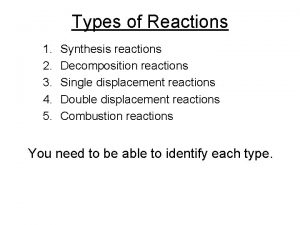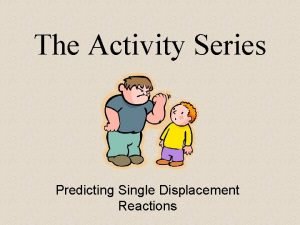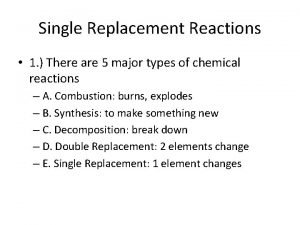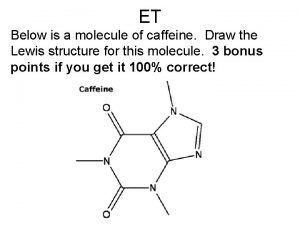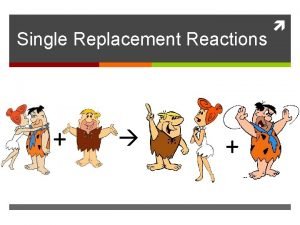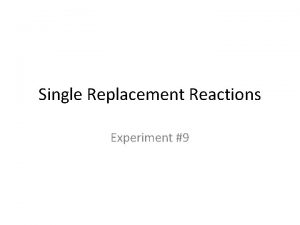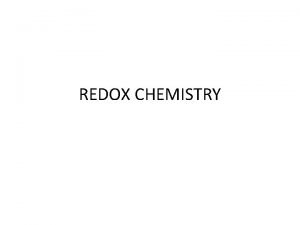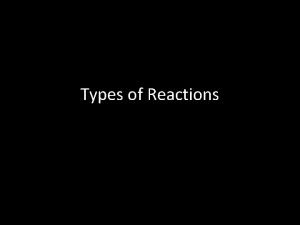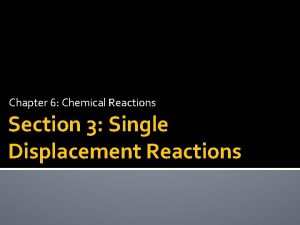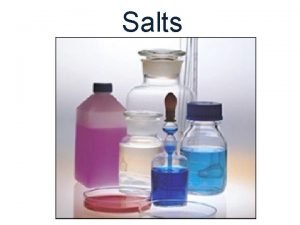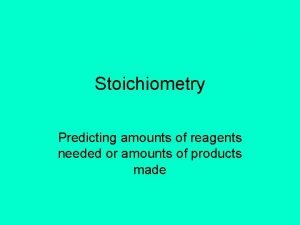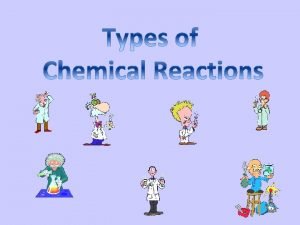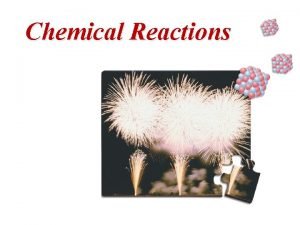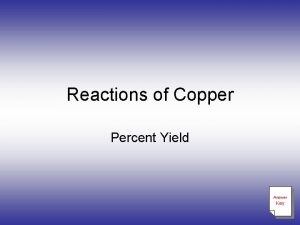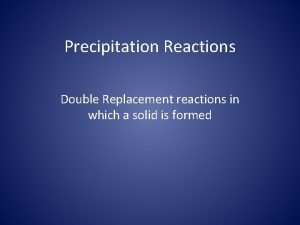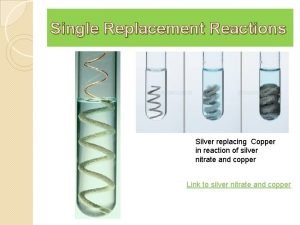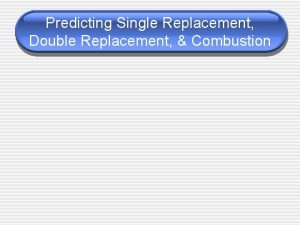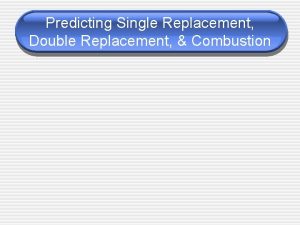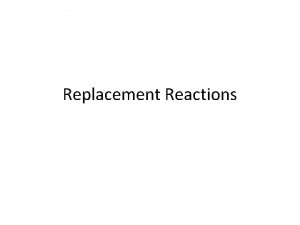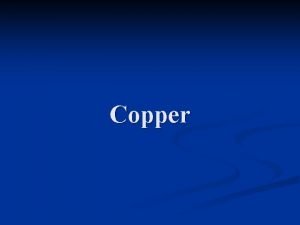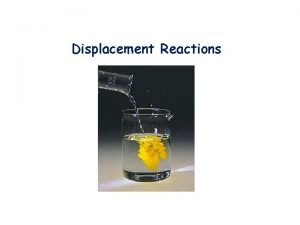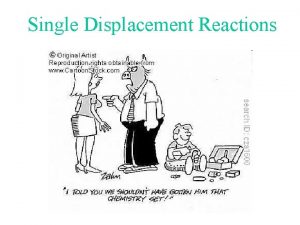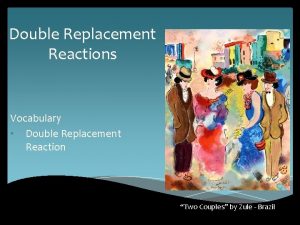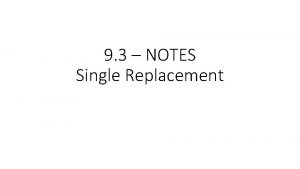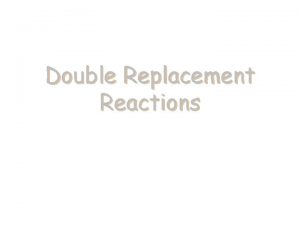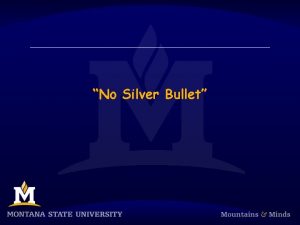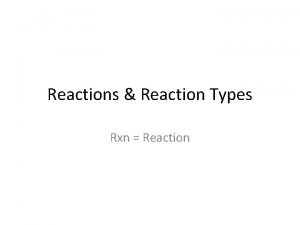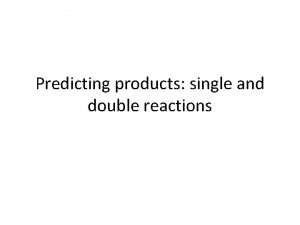Single Replacement Reactions Silver replacing Copper in reaction


















- Slides: 18

Single Replacement Reactions Silver replacing Copper in reaction of silver nitrate and copper Link to silver nitrate and copper

“Like replaces Like” � Element �Metals + Compound → Compound + Element replace metals and halogens replace halogens. �MA + MBC → MAC + MB �Where MA and MB are metals, C is a nonmetal or negative polyatomic ion. �X 2 + MY → MA + Y 2 �Where M is a metal, X and Y are halogens (F, Cl, Br or I) �Link to Mc. Graw-Hill tutorial

Example #1: Demo of Aluminum + Copper(II) chloride Al (s) + Cu. Cl 2 (aq) → � Aluminum Cu+2 Cl Copper(II) Chloride solution Blue color is due to presence of Cu+2 ion dissolved in water -1

What is the reddish solid that formed? Why has the solution turned from blue to colorless? Immediately after mixing Final appearance after 30 minutes

Predicting Products of Al + Cu. Cl 2 rxn �Neutral metals don’t dissolve; + charged metals ions do dissolve � Lines of evidence: � Reddish solid = copper � Blue color disappears = Cu+2 is disappearing � Al dissolves (clear, colorless ion in water) � Conclusion: Al has replaced Cu �Al (s) + Cu. Cl 2 (aq) →

Predicting Products of Al + Cu. Cl 2 rxn �Neutral metals don’t dissolve; + charged metals ions do dissolve � Lines of evidence: � Reddish solid = copper � Blue color disappears = Cu+2 is disappearing � Al dissolves (clear, colorless ion in water) � Conclusion: Al has replaced Cu �Al (s) + Cu. Cl 2 (aq) → Al+3 Cl-1 + Cu

Predicting Products of Al + Cu. Cl 2 rxn �Neutral metals don’t dissolve; + charged metals ions do dissolve � Lines of evidence: � Reddish solid = copper � Blue color disappears = Cu+2 is disappearing � Al dissolves (clear, colorless ion in water) � Conclusion: Al has replaced Cu �Al (s) + Cu. Cl 2 (aq) → Al+3 Cl-1 + Cu Cu. Cl 2 (aq) → Al. Cl 3 (aq) + Cu (s) � 2 Al(s) + 3 Cu. Cl 2 (aq) → 2 Al. Cl 3 (aq) + 3 Cu (s)

Halogen replaces Halogen �A 2 + BC → BA + C 2 �Where B is a metal, A and C are halogens (F, Cl, Br or I) � KI(aq) + Cl 2 (aq) →

Halogen replaces Halogen �A 2 + BC → BA + C 2 �Where B is a metal, A and C are halogens (F, Cl, Br or I) �KI(aq) + Cl 2 (aq) → K+1 Cl-1 + I 2 (diatomic!)

Halogen replaces Halogen �A 2 + BC → BA + C 2 �Where B is a metal, A and C are halogens (F, Cl, Br or I) �KI(aq) + Cl 2 (aq) → K+1 Cl-1 + I 2 (diatomic!) �KI(aq) + Cl 2 (aq) → KCl + I 2

Halogen replaces Halogen �A 2 + BC → BA + C 2 �Where B is a metal, A and C are halogens (F, Cl, Br or I) �KI(aq) + Cl 2 (aq) → K+1 Cl-1 + I 2 (diatomic!) �KI(aq) + Cl 2 (aq) → KCl + I 2 � 2 KI(aq) + Cl 2 (aq) → 2 KCl + I 2 �Link to Potassium Iodide and Chlorine

Activity Series �Some processes are spontaneous in one direction but not the other � Example: Rock can fall from a cliff to the ground, but a rock on the ground can’t climb the cliff by itself.

Single replacement rxns will run in one direction but not the other �Example: Mg + 2 HCl → Mg. Cl 2 + H 2 �But Mg. Cl 2 + H 2 → No reaction �Link to Mg. Cl 2 + H 2 video Mg + HCl Energy Mg. Cl 2 + H 2 Rxn Progress

Data from your lab Metal Mg+2 (Mg. Cl 2) Cu+2 (Cu. Cl 2) Zn+2 (Zn. SO 4) Mg X + Cu NR X NR Zn NR + X X = not tested NR = No reaction + = reaction Link to activity series animations +

Using an activity series chart (table 3 -3) to predict whether a rxn will occur �Is the element in reaction a metal or a halogen? (To decide which chart column to use) �What is the metal or halogen in the compound? �If the element is higher on the activity chart than the metal or halogen in the compound the reaction will occur.

Example #1: Will the following rxn occur? � Ag + HCl → � Step #1: Element is Ag = metal � Step #2: Metal in compound is always first element in formula = H. � On metal activity chart, is element, Ag, higher than H? � No, Ag is lower No reaction will occur.

Example #2: Will a rxn occur? � F 2 + KCl → � Step #1: Element = F 2, a halogen � Step #2: Halogen is formula is always second = Cl � Step #3: Is element (F) higher than halogen (Cl) in compound? � Yes; rxn will occur. � Products: Cl 2 and KF

Applications of Activity Series: A more active metal being used to protect a metal supporting a structure � Using Zinc (more active) to protect iron (less chemically active but physically stronger); the iron inside the concrete is helping to support the weight of the bridge
 Combustion reaction equation
Combustion reaction equation Predicting single replacement reactions
Predicting single replacement reactions Single replacement activity series
Single replacement activity series How to solve single replacement reactions
How to solve single replacement reactions Draw the structure of caffeine
Draw the structure of caffeine A+bx=ax+b
A+bx=ax+b Single replacement reaction experiment
Single replacement reaction experiment Single replacement definition chemistry
Single replacement definition chemistry Example of single replacement reaction
Example of single replacement reaction General equation for single displacement reaction
General equation for single displacement reaction Decomposition reaction example
Decomposition reaction example Stoichiometry predicting amounts in reactions
Stoichiometry predicting amounts in reactions Single displacement reaction cartoon
Single displacement reaction cartoon Bedroom silver carpet
Bedroom silver carpet Example of chemical change
Example of chemical change Chemical reaction of copper and percent yield
Chemical reaction of copper and percent yield Are precipitation reactions double replacement
Are precipitation reactions double replacement Chapter 11 chemical reactions answers
Chapter 11 chemical reactions answers Types of reactions
Types of reactions
